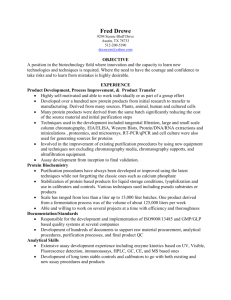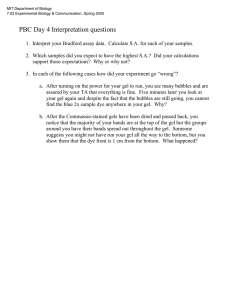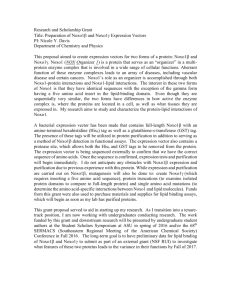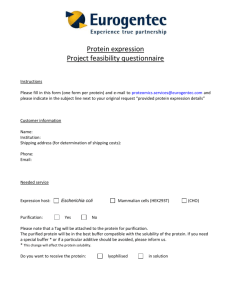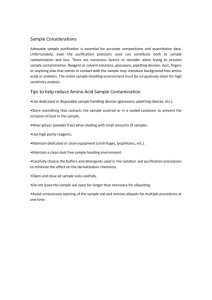7.340 Virus Structure and
advertisement
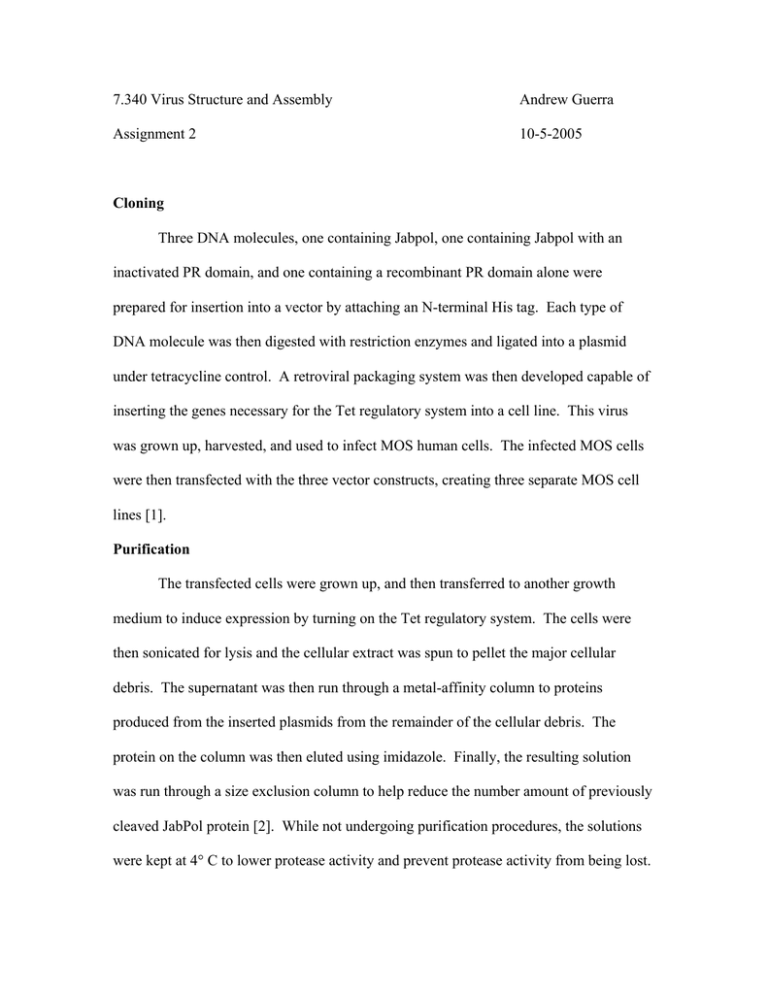
7.340 Virus Structure and Assembly Andrew Guerra Assignment 2 10-5-2005 Cloning Three DNA molecules, one containing Jabpol, one containing Jabpol with an inactivated PR domain, and one containing a recombinant PR domain alone were prepared for insertion into a vector by attaching an N-terminal His tag. Each type of DNA molecule was then digested with restriction enzymes and ligated into a plasmid under tetracycline control. A retroviral packaging system was then developed capable of inserting the genes necessary for the Tet regulatory system into a cell line. This virus was grown up, harvested, and used to infect MOS human cells. The infected MOS cells were then transfected with the three vector constructs, creating three separate MOS cell lines [1]. Purification The transfected cells were grown up, and then transferred to another growth medium to induce expression by turning on the Tet regulatory system. The cells were then sonicated for lysis and the cellular extract was spun to pellet the major cellular debris. The supernatant was then run through a metal-affinity column to proteins produced from the inserted plasmids from the remainder of the cellular debris. The protein on the column was then eluted using imidazole. Finally, the resulting solution was run through a size exclusion column to help reduce the number amount of previously cleaved JabPol protein [2]. While not undergoing purification procedures, the solutions were kept at 4° C to lower protease activity and prevent protease activity from being lost. Assay The assay of PR activity was performed at physiological conditions to ensure that sites cleaved in the in vitro reaction would also be cleaved in vivo. The assay was set up through three reactions, one with JabPol only, one with JabPol without a functional PR domain, and one with JabPol and the recombinant PR protein. Initial aliquots were taken from each of the three reactions as they began, then again every 30 seconds. Immediately after each aliquot was removed from the reaction mixture, it was heated to denature the proteins involved and stop the reaction. In addition, SDS and the other reagents required for a PAGE gel were added shortly thereafter to ensure the sample was completely denatured. After 10 minutes, the samples were loaded onto a SDS gel, and the gel was run. This gel showed that the JabPol with a mutated PR domain never underwent cleavage, remaining constant throughout the reaction. The JabPol alone began the reaction slightly processed, and became more so during the reaction. The JabPol with the separate PR protein was also processed, both more quickly and in a different order than JabPol alone. Site-Directed Mutagenesis From the sequence of the JabPol protein, it was theorized that the cause of the constraint on JabPol processing was caused by the presence of proline, an inflexible amino acid, as the first amino acid in the PR. To test this hypothesis, a Quick Change Site Mutagenesis Kit (Stratagene) was used to alter the amino acid in question from proline to alanine. The resulting DNA was sequenced to ensure that the correct amino acid would be translated [3]. This DNA then underwent the cloning and protein purification process as described above. Finally, an assay was set up as above, with the JabPol alone reaction replaced with the new mutant JabPol. The results of the gel for this assay showed that the processing speed and order was more similar to the JabPol and PR reaction, confirming that the proline plays a role in constraining PR activity in cis. References 1 Agu C, Klein R, Schwab S, et al. The cytotoxic activity of the bacteriophage λ-holin protein reduces tumor growth rates in mammary cancer cell xenograft models. The Journal of Gene Medicine 2005. 2 Hou E, Prasad R, Beard W, Wilson S. High-level expression and purification of untagged and histidine-tagged HIV-1 reverse transcriptase. Protein Expression and Purification 2004; 75-86. 3 Banci L, Benvenuti M, Bertini I, et al. From an Inactive Prokaryotic SOD Homologue to an Active Protein through Site-Directed Mutagenesis. Journal of the American Chemical Society 2005; 13287-13292.
